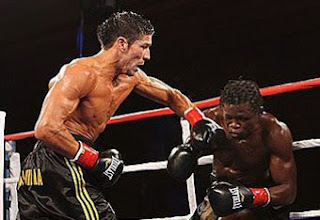There are several general concepts, which helped to shape the specific program. First, the work profile of boxing is repeated 3-minute rounds of activity, often with very high intensity bursts within a round. The rounds are separated by one-minute rest intervals. Thus, the relative contribution of anaerobic energy release pathways is considered extremely important, with aerobic capacity playing an important role in terms of facilitating rapid recovery. Extreme conditioning is required to fight effectively for ten intense, 3-minute rounds and anaerobic endurance is a key aspect that cannot be overlooked.
Short of an early round knockout, boxers cannot afford to win only the early rounds of a fight. They must maintain an intense, but measured pace throughout a long and competitive bout. So conditioning counts almost as much as skill for boxing success. Optimal physical conditioning provides the platform from which the skills can be used. The best way to simulate the demands of boxing is to use conditioning methods, which mimic the work/rest ratio and integrated bursts of power that typify boxing. I continue to use "suicides" and different versions of my H.I.G.T program to keep my fighters as well as my clients in peak physical condition.
 Boxing is a highly individual sport. Fighters possess unique styles that create specific physical demands. Some rely on explosive strength ("power"), for others it's starting strength ("speed"), and for most a combination of the two ("speed-strength"). True champions change their style in a way that will make them more able to attack the weaknesses of any given opponent. Improvements in specific capacities can be made, but they are only helpful if integrated into the fighter's style. For example, extensive footwork exercises may not benefit the power puncher who fights stationary and looks to deliver a blow that starts with the legs and drives right through the opponent, and wins that way. Similarly, a fighter who relies on punching speed and fast footwork should not put all his training hours into heavy bag work and muscle mass development. So, the program designed must not only be specific to boxing, but also specific to the boxer.
Boxing is a highly individual sport. Fighters possess unique styles that create specific physical demands. Some rely on explosive strength ("power"), for others it's starting strength ("speed"), and for most a combination of the two ("speed-strength"). True champions change their style in a way that will make them more able to attack the weaknesses of any given opponent. Improvements in specific capacities can be made, but they are only helpful if integrated into the fighter's style. For example, extensive footwork exercises may not benefit the power puncher who fights stationary and looks to deliver a blow that starts with the legs and drives right through the opponent, and wins that way. Similarly, a fighter who relies on punching speed and fast footwork should not put all his training hours into heavy bag work and muscle mass development. So, the program designed must not only be specific to boxing, but also specific to the boxer. Ideally, the boxing punch consists of synchronization between arm, leg, and trunk actions. The punching movement of a boxer consists of leg extension, trunk rotation, and arm extension, in succession. The more effective the coordination between arms, legs and trunk movements are the greatest and the impact force of a punch. The leg muscles play a vital role in the power developed in this sequence. Increasing leg force development and coordinating it with trunk and arm action is probably the most effective way to increase punching power.
Because boxing is an explosive sport, ballistic training methods are especially effective during weight training for boxing. This kind of training method requires the athlete to perform each repetition explosively, with maximal intended velocity. Finally, in my view, the best way to weight train for competitive boxing is via a cycled training schedule. This type of training schedule integrates workouts and exercises that will meet all the basic performance demands of boxing, strength, power, speed, agility, and strength endurance.



